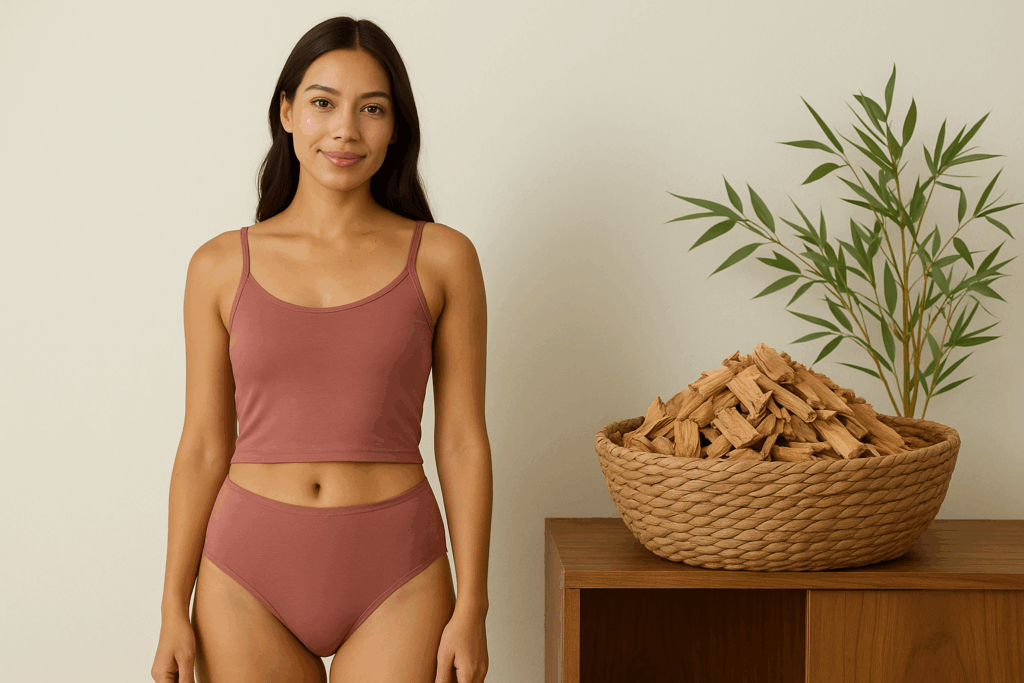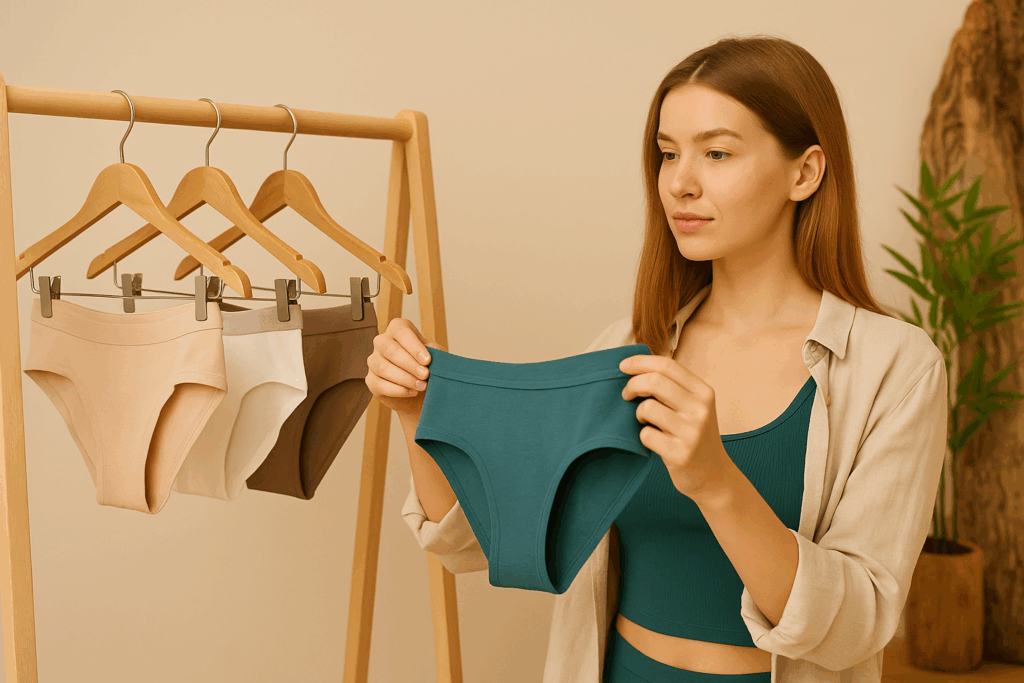If you’re on the hunt for underwear that feels like a dream against your skin while keeping you fresh and comfortable all day, Tencel/Lyocell fabric is the way to go. Imagine slipping into something with the softness of silk but the durability and breathability that outperforms traditional fabrics. Sounds great, right? Let’s dive into what makes Tencel/Lyocell the top choice for women’s underwear and how it stacks up against cotton and synthetic options. Plus, I’ll guide you on selecting the perfect style and caring for your investment while highlighting its surprisingly green credentials.

What Makes Tencel/Lyocell Fabric a Top Choice for Women’s Underwear
Tencel and Lyocell—terms often used interchangeably—are actually the same type of fabric made from natural wood pulp, usually eucalyptus trees. It starts with the cellulose extracted from these trees, which is then dissolved and spun into fibers using an environmentally friendly closed-loop process. This technique not only uses fewer chemicals but also recycles water at a tremendously efficient rate, making Lyocell a sustainable option [1][4].
What sets Tencel/Lyocell apart is how its fiber structure impacts the fabric’s feel and function. Unlike cotton or synthetic fibers, Tencel has a nanostructure that efficiently absorbs moisture and draws it away from the skin. That means when you wear Tencel underwear, it regulates moisture better, preventing that sticky, uncomfortable feeling we all dislike [9]. Plus, it has a smooth surface that feels incredibly soft—much like silk—while also being strong and breathable.
So why is this important for women’s underwear? Because this unique combination of softness, moisture management, and strength supports comfort and fit in ways ordinary fabrics can’t match. It’s lightweight but tough enough to retain shape even after repeated washings.
How Tencel/Lyocell Is Made and Its Unique Origins
Here’s the fascinating bit: Tencel’s production uses sustainably harvested wood. The pulp comes mainly from fast-growing trees like eucalyptus, which require less water than cotton and no fertilizers or pesticides [1]. The fabrication process includes dissolving the pulp in a non-toxic organic solvent, spinning it into fibers through a spinneret, and recovering almost 99% of solvents for reuse in a closed-loop system [4].
This method is unique compared to cotton farming, which is water-heavy and pesticide-reliant. It results in fibers with high purity that lend softness and strength to the fabric and supports the growing demand for eco-conscious textiles.
Key Features of Tencel/Lyocell That Enhance Comfort and Fit
What’s really brilliant about Tencel underwear? Check these out:
- Silk-like softness: The smooth fiber surface reduces friction, avoiding irritation, especially important for sensitive skin [9].
- Moisture-wicking: It absorbs moisture 50% better than cotton, leaving you dry and comfy all day [9][12].
- Breathability: The fibers allow air to flow freely, reducing overheating.
- Durability: Despite its softness, Tencel keeps its shape and resists tearing, stretching or pilling [3].
- Hypoallergenic: Great for women prone to allergies or sensitive skin, as it repels dust mites and bacteria naturally [7].
Combine these features, and you get underwear that fits like a well-tailored layer of second skin.
Why Choose Tencel/Lyocell Underwear for Your Everyday Comfort
Let’s be honest, underwear isn’t just about looks. It’s about how it feels when you move throughout your day. That’s where Tencel’s superior comfort features shine.
The Superior Softness and Gentle Feel on Sensitive Skin
Ladies with sensitive skin, this one’s for you! Tencel underwear is a blessing if you suffer from irritation, eczema, or simply dislike that scratchy feeling some fabrics cause. Its smooth fibers minimize friction, so you’ll find less redness and chafing, even with extended wear [9]. Also, because the fabric is soft but performs well during activity, it’s perfect for workout days or long office hours.
Many users report that Tencel feels like silk but breathes like cotton, which means softness without sacrificing comfort during movement.
How Breathability and Moisture Management Improve Wearability
Sweat and underwear? Not a good combo! Tencel’s moisture management is its superpower. It pulls sweat away from your skin and spreads it across the surface to dry quickly. This keeps you feeling fresh—no matter how busy or warm your day gets [9].
This breathability also reduces the risk of yeast infections or bacterial growth—common issues with synthetic fabrics. It’s why Tencel underwear is often recommended for those with delicate skin conditions or even medical needs [8].
Hypoallergenic Benefits for Women with Sensitive Skin or Allergies
If you’re prone to allergies or sensitive skin reactions, here’s some relief: Tencel fibers inhibit dust mite and microbial growth thanks to their moisture-wicking properties and smooth structure [7]. This naturally reduces common allergens around your nether regions, making your underwear more than comfortable—it’s protective.
Imagine underwear that works with your body—not against it. That’s a huge plus for daily wear.
Easy Care and Durability Compared to Other Common Underwear Fabrics
You might worry that this kind of softness comes with a laundry hassle—but nope. Tencel underwear is easy to care for. It resists shrinking, stretching, and fading if washed correctly. Gentle washing in cold water, avoiding bleach, and air drying preserves its integrity [6].
Plus, it’s durable. You won’t need to replace it after a few wears, which is great for your wallet and the planet.
Alright, now that you know the benefits, how does it stack up against other fabrics?
How Tencel/Lyocell Underwear Compares to Cotton and Synthetic Options
Why Tencel/Lyocell Often Outperforms Cotton in Comfort and Sustainability
Cotton has long been the gold standard for underwear—breathable, soft, and natural. But there are some downsides. Cotton farming is water-intensive and pesticide-heavy. Also, standard cotton fabric retains moisture longer, which can cause discomfort and skin issues. On the flip side, Tencel uses far less water and fewer chemicals in production [1][4].
From a wearer’s perspective, Tencel undergarments feel softer and drier on the skin. Studies comparing cotton and Tencel blends reveal better moisture management and less shrinkage with Tencel content in underwear fabrics [10][12]. So, if you want comfort and an eco-friendly footprint, Tencel wins.
Advantages of Tencel/Lyocell Over Polyesters and Nylon in Everyday Wear
Synthetic fabrics are often durable and stretchy but can trap heat and moisture, causing skin irritation or odor buildup over time. Tencel, in contrast, excels in breathability and moisture transport, making it much more comfortable for everyday and active wear [9][11].
Moreover, Tencel is biodegradable, unlike petroleum-based synthetics, which take decades or longer to break down in the environment. So, your Tencel underwear isn’t just good for you—it’s good for Mother Earth.
Selecting the Perfect Tencel/Lyocell Underwear Style for Your Needs
Exploring Different Fits and Designs Made with Tencel/Lyocell

Tencel underwear comes in a variety of cuts and styles tailored for different preferences—from classic briefs to cheeky bikinis, seamless thongs, and even sports bras. Thanks to the fabric’s stretch and recovery, you’ll notice a hug that moves with your body without digging in or sagging.
Brands use Tencel in blends with small amounts of elastane or cotton for added flexibility, ensuring your undies fit perfectly while retaining the silk-like softness [3]. Whether you prioritize everyday comfort or something more supportive for workouts, there’s a style waiting for you.
Identifying High-Quality Tencel/Lyocell Underwear Brands You Can Trust
Not all Tencel-labeled products are created equally. Look for reputable brands that disclose their fiber content (ideally 100% Tencel or with minimal blends) and responsible sourcing certifications, such as Forest Stewardship Council (FSC) approval, to guarantee eco-credentials [1].
Reviews also help—seek customer feedback on fit longevity, softness retention, and colorfastness. Brands that offer clear care instructions and stand behind their products usually indicate quality.
Understanding Price Points and Finding the Best Value for Your Budget
Tencel underwear can sometimes be pricier than basic cotton or synthetics. However, consider this: its durability, superior comfort, and longer lifespan often make it a better investment.
If budget’s tight, some affordable brands blend Tencel with cotton or another fiber to keep costs down while delivering improved softness and breathability over pure cotton products [10]. Think of it this way—you’re paying for quality, sustainability, and well-being.
How to Care for Your Tencel/Lyocell Underwear to Keep It Looking and Feeling Great
Effective Washing and Drying Practices to Maintain Fabric Softness and Shape
To keep your Tencel underwear feeling like new:
- Wash in cold or warm water on a gentle cycle
- Use mild detergent—no bleach or fabric softeners
- Air dry whenever possible; avoid tumble drying on high heat
- If ironing, use low temperature
These steps preserve fiber integrity and avoid pilling or shrinkage, ensuring the softness and fit last [6].
Common Care Mistakes to Avoid That Could Damage Your Tencel/Lyocell Pieces
Beware of throwing Tencel underwear into the washing machine with heavy garments like jeans or towels, as abrasion can cause microdamage. Also, avoid prolonged soaking which can weaken fibers, and skip bleach or harsh detergents altogether—they degrade Tencel’s unique fiber structure [6].
If you follow these guidelines, your underwear will remain a comfortable staple for months or even years.
The Environmental Benefits of Choosing Tencel/Lyocell Underwear
How Sustainable Production Practices Make Tencel/Lyocell Eco-Friendly
Tencel is a leader in eco-friendly fabric manufacturing. Its production uses renewable wood sources, minimal water compared to cotton, and a closed-loop process that recycles over 99% of chemical solvents. Plus, the fabric is fully biodegradable, returning to nature without harmful residues [1][4].
Choosing Tencel underwear means supporting a circular economy in textiles—a step forward in reducing the fashion industry’s environmental impact.
Comparing the Environmental Impact of Tencel/Lyocell to Other Fabric Choices
When lined up against cotton and synthetics, Tencel boasts a substantially lower water footprint and fewer greenhouse gas emissions per kilogram of fabric produced. Synthetic fabrics rely on petroleum extraction, with associated pollution and non-biodegradability, while cotton cultivation demands heavy irrigation and pesticides [1].
By opting for Tencel, you help reduce chemical runoff, conserve water, and prevent long-lasting plastic pollution, giving you peace of mind alongside comfort.
